Enjoying the beautiful spectacle of birds in your backyard during the summer heat can be a joyous pastime. As a bird lover, you might wonder, “When should I stop feeding birds in the summer?”
The answer is simple: Don’t stop! Feeding birds in the summer will not only provide your feathered friends with supplemental nourishment but also offers you a fantastic bird-watching experience.
In summer, there are likely to be many more food sources available to wild birds in the natural world, so it will be easier for them to find food on their own without your intervention.
Nonetheless, in urban environments in particular – where wild habitat is not necessarily abundant – there is a lot you can do to make sure that birds get what they need during the warmest and sunniest part of the year.
Why Feed Wild Birds in Summer?
Feeding birds can be beneficial throughout the whole year. Of course, there are many reasons to do so in every season. But feeding backyard birds in summer can be beneficial for several reasons beyond avian welfare.
To Attract a Wider Range of Species, and Birds in Greater Numbers
In the northern United States and Canada, summer is the time when far more species are present and when far more birds (in number) are around.
In many areas, it will be possible to attract more species and greater numbers to your garden at this time than at any other time of the year. So you will be exposed to more bird life when feeding at this time of the year and be able to check more species off your list.
To Witness Breeding Season Plumage and Behaviors
Remember, in many regions and for numerous bird species, summer is the breeding season when eggs are laid, and nestlings and fledglings are reared.
During the breeding season, the males of some species take on a different appearance, with more colorful or noteworthy plumage. These visual cues can be interesting for those interested in bird identification.
If you feed birds in your garden during this time, you could be helping them raise the next generation and will potentially be able to witness some very interesting bird behaviors as they pair off, procreate, and raise their young.
So feeding in summer can help you learn more about how birds interact with one another, how they court, rear their young, and feed themselves and their offspring during this season.
To Gain the Benefits of Birds as a Gardener
Not everyone realizes this, especially if they have encountered birds that can become a nuisance in the vegetable garden. but in edible and ornamental gardens, attracting plenty of birds to your space can make organic gardening easier.
Birds offer a range of natural ecosystem services that help us work with nature to grow in our gardens. They bring fertility and add this to the soil. They can help to spread seeds. They can eat insect pests etc., and help in organic pest control. Some aid in pollination.
The more wildlife, including birds, we can attract to our summer gardens, the more healthy, functioning, and productive our growing spaces can be.
Feeding birds in summer can also be easier for beginners than feeding birds at other times of the year.
How to Feed Birds in Summer
It is always important to remember that different birds will have different nutritional needs and different diets. Some birds will eat seeds, some will eat nectar or sugar-water solution, some will eat fruits, berries, and jellies, and many will eat insects. Many birds will eat a combination of the above, while some eat a much more limited diet.
Understanding which birds are present in your area and which you might attract is the first step in making sure that you offer the right food sources during the summer months.
Provide for Garden Birds Through Your Planting Decisions
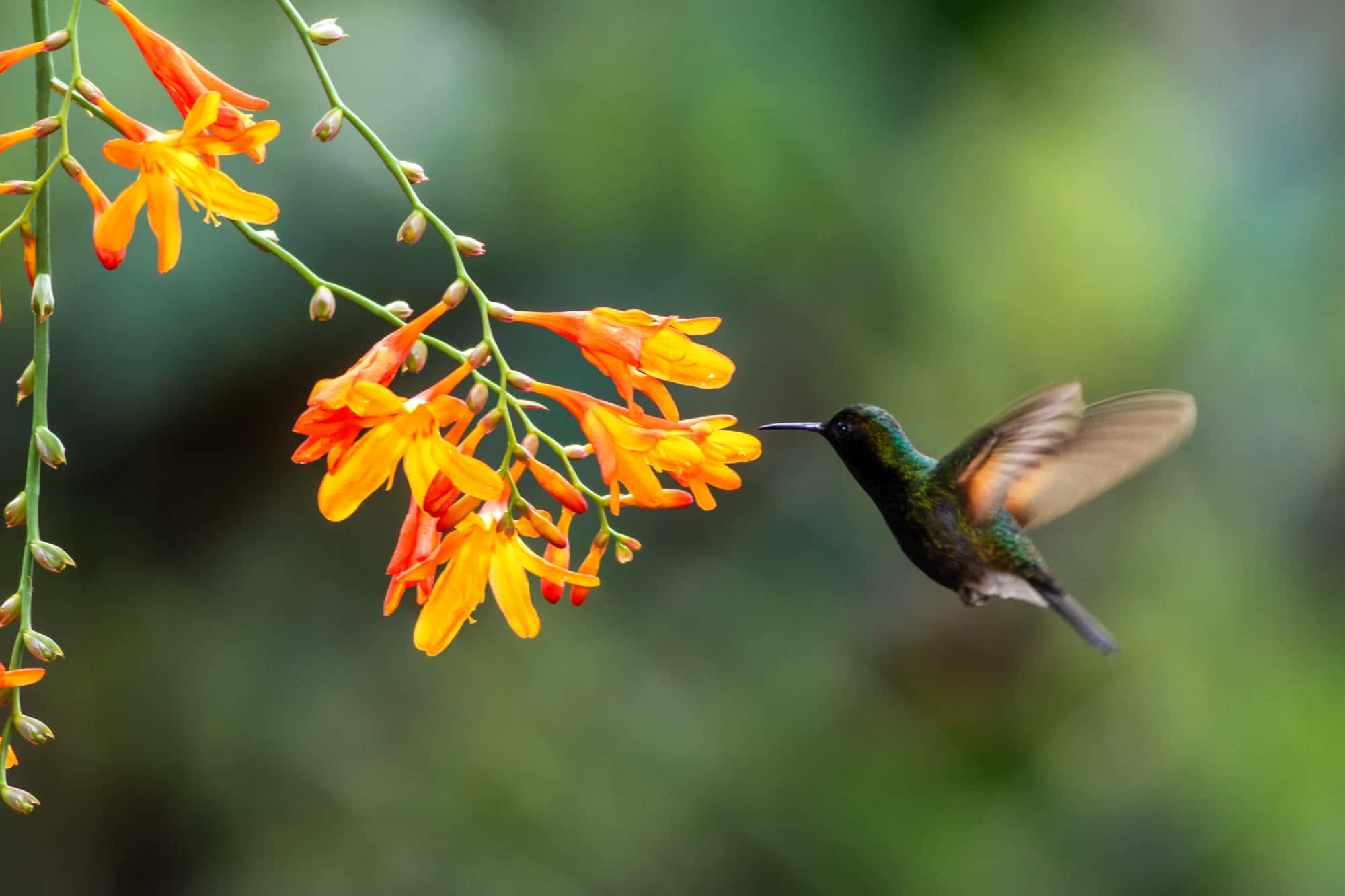
Those seeking to feed the birds often leap first to backyard bird feeders. But placing feeders to supplement the diet of wild birds sharing your space is not the only, nor is it the most important, step in providing for garden birds.
If you are lucky enough to have a garden, then you can make sure you are feeding garden birds in more natural ways by planting things that provide the foods they like to eat.
Birds should always receive most of their nutrients from natural food sources, such as fruit trees, berry bushes, flowers, and plants that produce seeds.
When feeding birds in summer, the most worthwhile thing you can do is plant as wide a variety of native plants as possible to provide for their needs.
Create Some Habitats that Provide Food For Different Bird Species
As well as thinking about plant-based food sources from individual species of plants that will grow where we live, we should also think holistically to attract as many birds as possible to our gardens.
Remember, the right plants won’t just provide food for many bird species. They can also help to attract insects and other creatures that certain birds like to eat.
Creating habitats in your garden that are as biodiverse as possible is crucial for any truly bird-friendly garden. Diverse habitats attract not only birds but also a range of other wildlife. This helps make sure a garden can provide for all sustainably and in an eco-friendly way – truly standing the test of time.
Creating habitat means thinking about how you might not only choose the right plants, suited to where you live but also combine those plants in the most effective ways to create functioning ecosystems.
Working with nature to create areas of forest or woodland, forest gardens, and other predominantly perennial food-producing gardens, wildflower meadows or prairie planting, bog or rain gardens, wetland zones, wildlife ponds, native xeriscaping schemes, and more is a great bird-friendly strategy.
With habitats suited to the environment and conditions where you live, you can provide not only for yourself and your family but also for a huge range of backyard birds.
Add Different Feeders to Your Garden
Only once you have considered how to provide natural food sources for birds through native plant selection and habitat creation should you think about adding feeders to provide supplemental food.
Remember, food that birds can find at feeders should only ever be an addition to their diet and not provide the bulk of the nutrition they need.
To provide for as many different birds as possible, you should consider adding:
- Seed Feeders
- Nectar Feeders
- Fruit Feeders
- Mealworm Feeders
- Fat Feeders (with fats like suet) – though most useful in the coldest months, suet feeders can sometimes be beneficial in the summer too.
Understanding the difference between large bird food and small bird food is essential. Larger birds like crows and jays prefer food such as corn and sunflower seeds, while small birds like sparrows and finches enjoy thistle and millet.
Regardless of the size, summer is a critical time to provide wild bird feed, as many adult birds are busy raising their young and appreciate the extra help!
Seed Feeders:
What Seed Feeders Are Best?
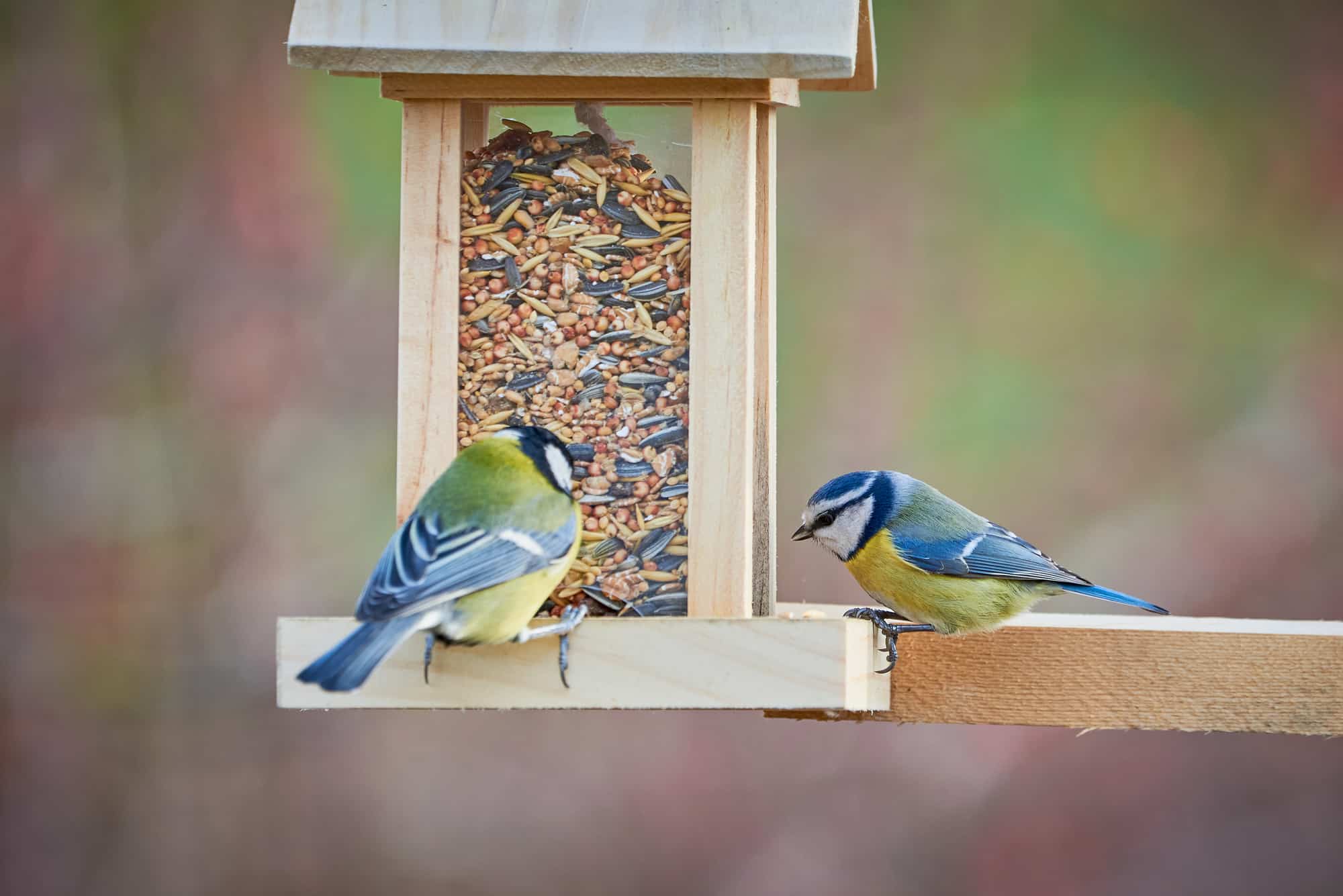
Seed feeders filled with the most popular wild bird food, black-oil sunflower, will always attract the largest variety and number of birds.
Mixed seed with black-oil sunflower, striped sunflower, peanuts, white millet, and corn is also a good mix but may be a little harder to come by, as many sellers have mixes filled with grains and other seeds that most songbirds we want to attract don’t eat. Learn what happens when you put a bad mix in your feeders.
Goldfinches are attractive birds to see at feeders.
To attract these beautiful birds for backyard bird watching, put out a specially adapted feeder filled with nyjer, as this tiny black seed is their favorite food.
But only put out enough for it to be eaten in a day as Nyjer seed spoils very quickly and can grow mold, or leave it for winter bird feeding when the temperatures are cooler.
How To Serve Seed?
Black-oil sunflower seed and mixed seed are best served in chalets, hopper-style feeders, and platform feeders.
Tube feeders are best filled with black-oil seed as the mixed seed that does not get eaten will clog up the feeder with uneaten seed.
Shelled sunflower is like nyjer seed, once taken out of its protective shell it deteriorates faster and therefore should be served in small amounts or saved for cool weather.
Nectar Feeders:
What Birds Will Nectar Feeders Attract?
Syrup feeders for Hummingbirds and Orioles are exciting summer bird feeding venues.
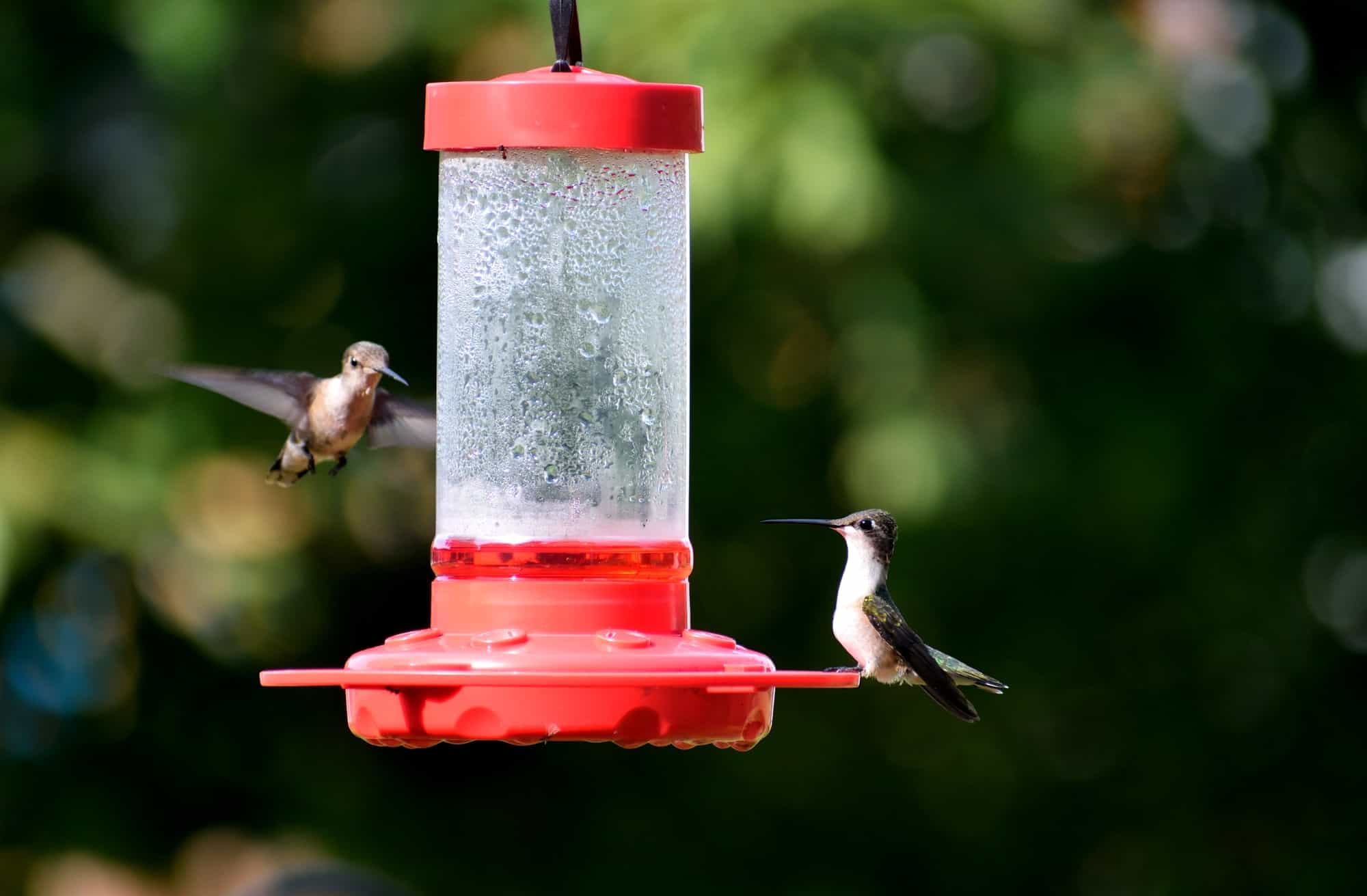
At one house we lived in, a pair of Baltimore Orioles used our feeder for a number of years.
The male always brought the young with him to the feeder when they were old enough.
We also had House Finches use our nectar feeders regularly too.
How To Use Syrup Feeders?
Ant moats keep ants from filling up your nectar feeders.
They are simply a reservoir to hold water which the ant must cross to get to the nectar.
Ants are highly attracted to the sweet liquid, so buy a feeder with a built-in ant mote or purchase a mote to place between the hook and the feeder. This works to keep them out.
The ants drown before they get into the nectar.
Some oriole feeders have bee guards built into the feeding ports, which is a very fine feature for keeping bees alive and out of your syrup.
To keep the feeders less attractive to bees, It is helpful to keep your feeders clean on the outside and not let the nectar drip when you are hanging them back up.
One of the greatest causes of dripping nectar feeders is tightening them too far after filling them. Try to stop when you feel it catch. Resist the urge to give it one extra turn to tighten it up a little more. Tightening too far can cause the threads to leak.
Hummingbirds, though, sometimes find the bee guards on Oriole feeders difficult to push past to get into the syrup.
So if you want to purchase a nectar feeder for both types of birds to use then avoid one that has bee guards.
But, better still, purchase one feeder suitable for Hummingbirds and one for Orioles.
There are special bee guards for hummingbird feeders too. This way, the bees can be happy too and stick with flowers!
Fruit Feeders

Fruit feeders are also a simple way to attract different birds which do not frequent seed feeders.
Fresh fruit served up daily, such as oranges, grapes, apples, or bananas, will be a welcome wild bird food for many.
Some of the birds you may attract with a variety of fruit are Woodpeckers, Orioles, Gray Catbirds, Bluebirds, Cedar Waxwings, Northern Mockingbirds, Robins, Towhees, House Finches, Rose Breasted Grosbeaks, and Scarlet Tanagers.
Fruit can also be fed to birds in the form of jelly or compote.
Grape jelly and apple jelly are two favorites, but experimenting with other flavors can also be very rewarding.
Choose brands that do not have additives, as birds have such small bodies compared with ours and can be affected by chemical additives.
Orioles will especially be appreciative of this treat, but many other birds will have a taste, too, like Red-breasted Grosbeaks and House Finches.
How To Feed Jelly To Birds?
There are many attractive jelly feeders on the market.
Some have a roof that prevents rain from filling up the feeder, which is very helpful in keeping the jelly from being diluted with rainwater.
Here is one I made out of a plastic juice bottle, and here is a good selection that can be purchased.
Mealworm Feeders:
What Birds Like Mealworms?
Another type of delectable wild bird dish that can be added to the summer bird feeding buffet table or any season is mealworms.
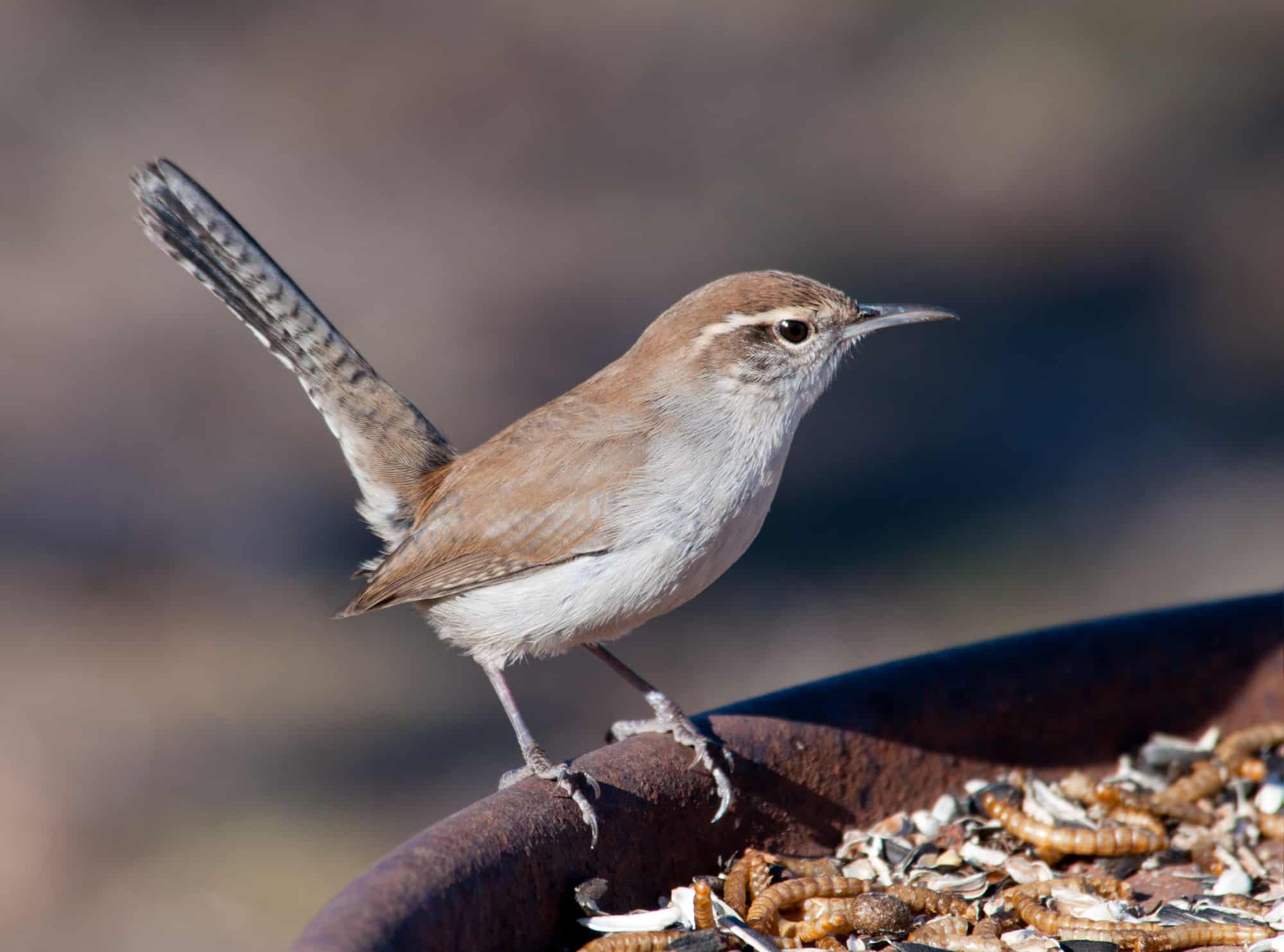
Who could possibly resist freeze-dried mealworms? Not Bluebirds or many other bug-eating birds.
At first thought, this may not appeal to some bird watchers. But learning that Blue Birds, Warblers, Woodpeckers, and other insect-eating species will be grateful diners helps to take the distaste away from serving such a meal.
Don’t miss out on this wonderful bird-watching opportunity.
How To Serve Mealworms?
As an Amazon Associate, I earn from qualifying purchases.
Mealworms ~ Who can resist?
The feeders below were selected because dried mealworms are very lightweight and will blow easily out of a feeder if not protected from the wind.
Dried and live mealworms are selected below, but be aware that live ones are quite “frisky” and will need to be contained, or they will crawl away!
Suet (Or Other Fat) Feeders:
Can You Feed Suet To Wild Birds In Summer?
Bird feeding with suet is typically something done in the cooler months and over winter. But this can potentially be helpful in summer too. If you’re wondering what to put in a suet feeder in summer, then look no further than no-melt suet.
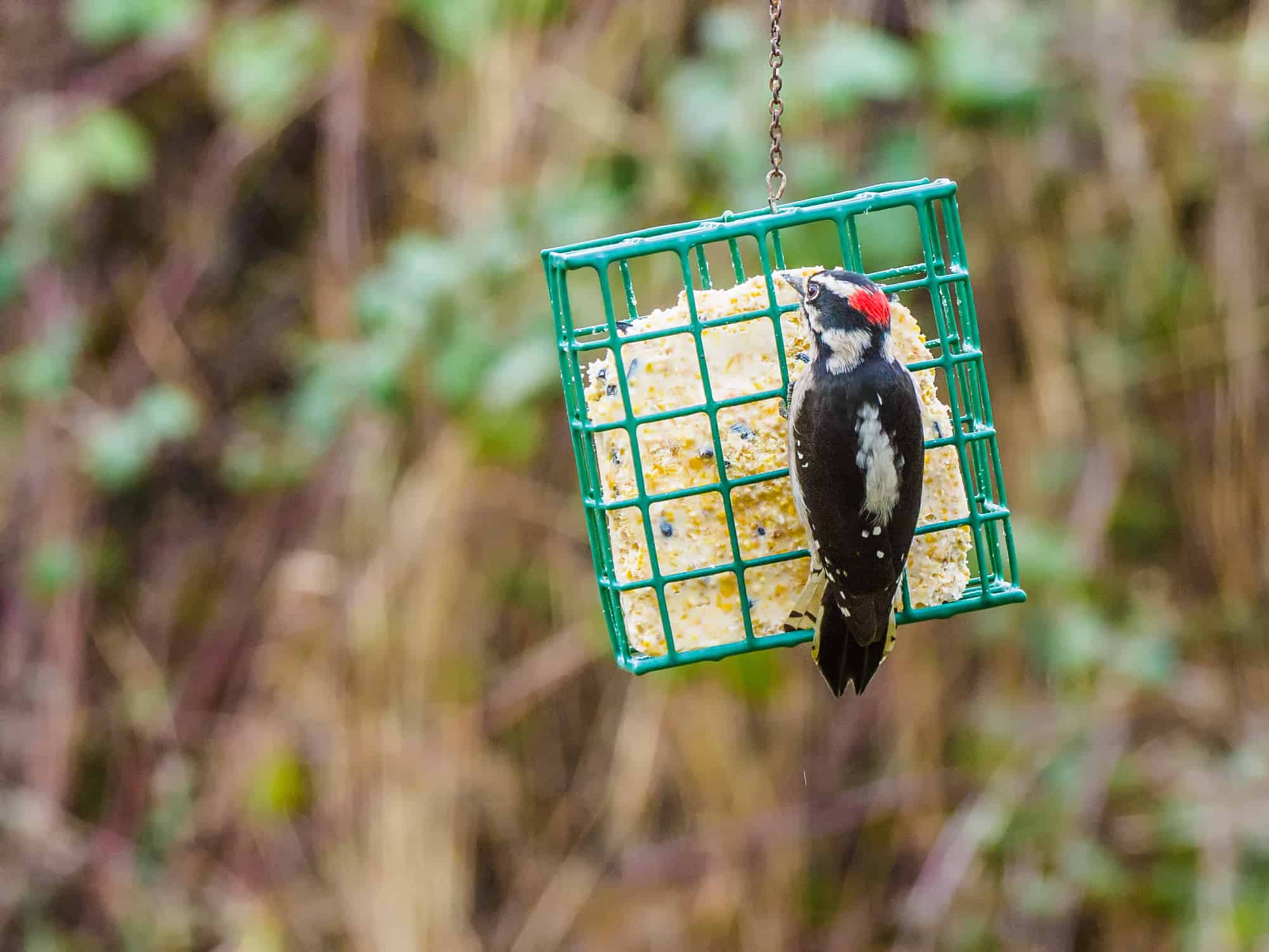
No-melt, or summer suet, is heated so that it resists melting during higher summer temperatures. More about suet.
It should not contain preservatives.
It is best to hang it in the shade, where it will be a little cooler.
Parent birds of many species will feed suet to their young as an energy booster to their diet.
Woodpeckers, Chickadees, and Nuthatches, who are the birds we usually think of as suet eaters, will appreciate the year-round consistency of having this food in the summer as well.
See a good selection of Suet Feeders.
Other Ways to Attract Birds and Provide For Them in Summer

As well as providing food for birds in summer, it is also important to make sure that birds have other things that they need. If they can also meet their other needs in your garden, they are more likely to show up and more likely to stick around.
Provide Water for Drinking and Bathing

Wild birds require water like all living creatures. They need it for drinking, bathing, and, when all of their other needs are met, frolicking!
Providing water for drinking and bathing is best achieved by adding natural wildlife ponds or other water features, shallowly sloping at one side, with a beach area, and surrounding by and planted up with marginal and aquatic plants.
But you might also consider adding a man-made bird bath. And as long as you choose the right one, this can also help to attract birds to your space.
Birdbaths are also an exciting venue for backyard bird-watching and will attract birds that normally do not come to traditional bird feeders for seed.
Provide Places to Perch and Different Forms of Shelter
Birds need places to perch close to feeders throughout the year. They need to perch to survey their surroundings. Male birds also find perching important when they are showing courtship displays or defending their territory during the breeding season.
So make sure that you provide perches in trees or shrubs in your garden – planting to provide this as well as food wherever possible. When waiting for these plants to grow, you might also place man-made perches to make your garden optimal for birds to use
Provide Nesting Sites & Nest Boxes

Remember, summer is often the time when birds choose and use nesting sites. So make sure that in addition to feeding birds in summer, you also provide spaces for them to use.
Often, these will be created through planting and habitat creation. But you might also consider placing nesting boxes in your garden before the summer breeding seasons begin.
Additional Things To Consider When Feeding Birds In Summer
If You Do Summer Bird Feeding ~ Hygiene Is Important
In the summer, bird feeders and suet cages can become hotspots for bacteria, especially in hot weather. Regular cleaning is essential for preventing disease and ensuring your feathered friends stay healthy even during soaring summer temperatures.
If the food in a feeder is spoiling before it is eaten, put smaller amounts in the feeder.
Secondly, you may have to purchase a better-quality seed with no fillers.
The poor quality mixed seed contains types of milo and sorghum, a seed that wild birds don’t eat.
The result is the seed sits and rots, either in the feeder or on the ground where the birds have tossed it, causing the perfect environment for disease to grow and spread.
How to Have Patience
Patience with new bird feeders and baths is mandatory! It takes time for wild birds to adjust to any changes in a backyard.
It is best to place new feeders at least ten feet away from existing feeders until visitors frequent the new addition. It can then be moved if desired.
So, for summer bird feeding success, deck your backyard with a good variety of bird feeders, baths, and houses, and watch the avian highway grow!
Will birds migrate in the fall if you leave your feeders up?
Find out about seed feeders and Hummingbird feeders.
Should You Feed Birds in Summer?
Absolutely! Summer is a crucial time for feeding birds. Adult birds are busy raising their young, and supplemental feeding helps them greatly.
Should I Feed Birds Year-Round?
Yes, feeding birds year-round is ideal. With varying seasonal needs, your backyard birds will appreciate the constant source of food. Bear in mind, however, that different seasons may require different types of food.
More About Summer Bird Feeding
- Where have my backyard birds gone? – Any time of year, the birds in our backyards sometimes seem to disappear. It may not be a usual time for migration, which makes us wonder what happened to them. Discover the reasons.

